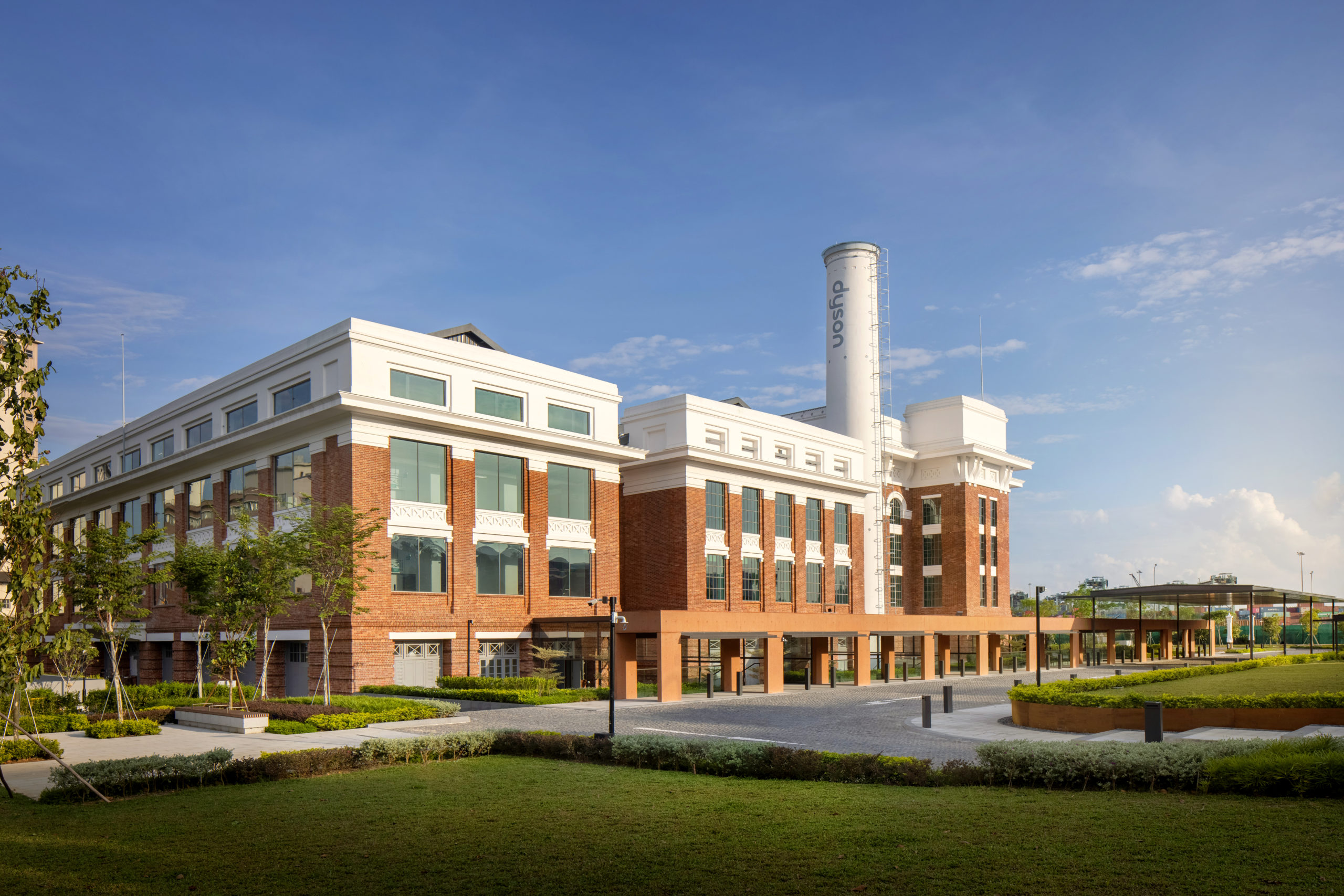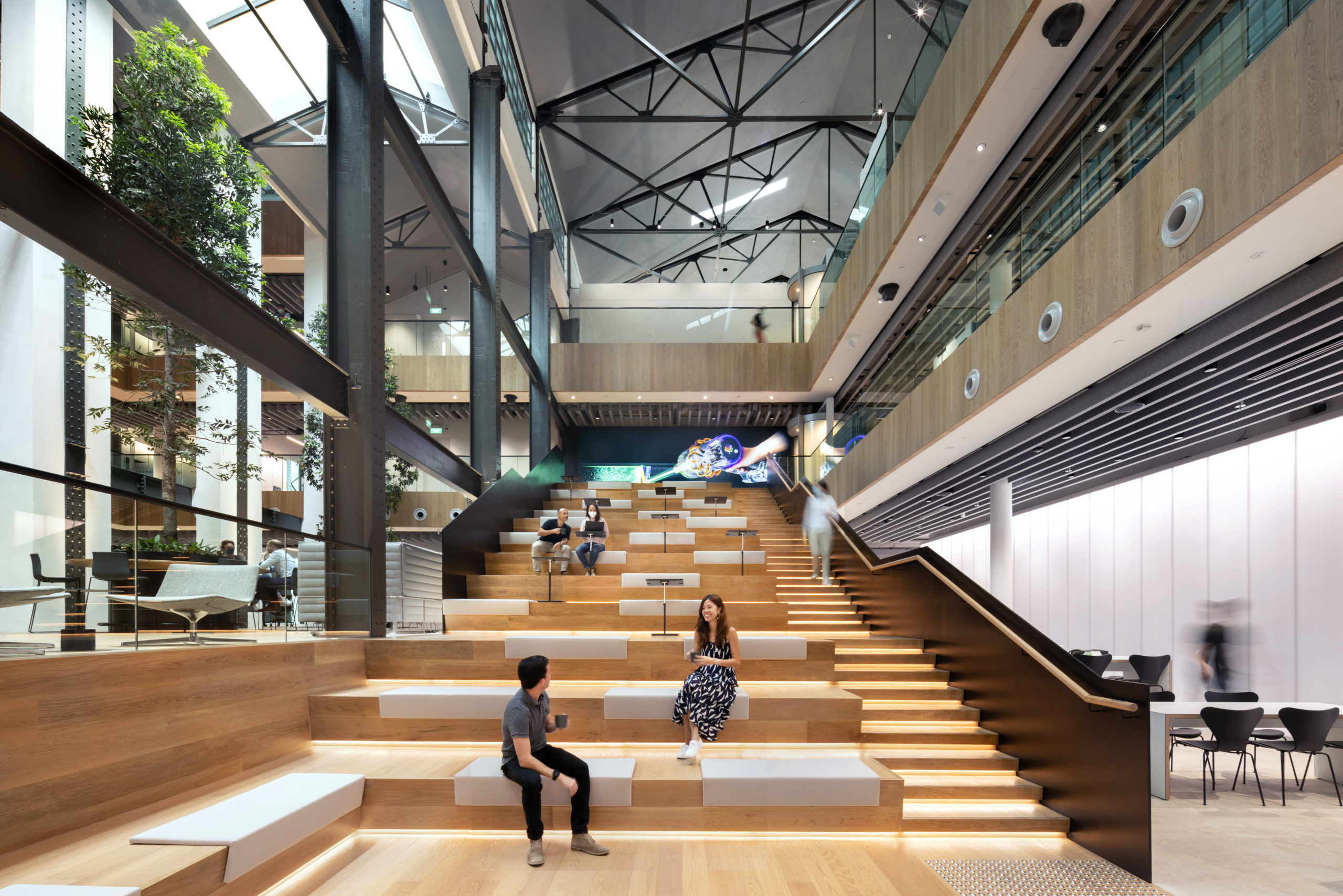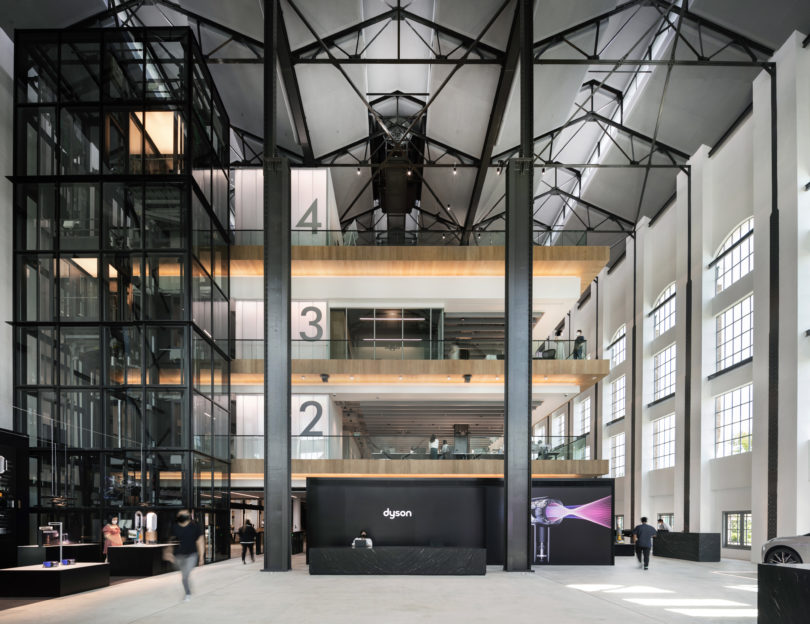The adaptive restoration of the historic St James Power Station for Dyson’s Global Headquarters was completed in April 2022. The rejuvenation of the now 97-year-old national monument is no mean feat—of particular note are the intricacies of mechanical engineering involved.
The showcase of the power station’s rich history and architectural heritage is all-important as pointed out by Anna Xu, Global Estates Director of Dyson, “With sustainability and well-being at its heart, we wanted people to see its good engineering, steel structure and rivets in all its honesty. Every intervention and detail were painstakingly considered to ensure that we were sympathetic and respectful to the building’s true character. We want our workplace to exemplify what is possible when engineers challenge convention, think big and persevere.”
In line with this vision, Aurecon was appointed to advise on the mechanical and electrical building systems; structural engineering; acoustics; specialist lighting; environmentally sustainable design; and fire engineering for the transformation.
We contacted Kelvin Chen, Technical Director – Buildings Mechanical of Aurecon and Javis Jee, Mechanical Engineer of Aurecon, for their insights.
Was Aurecon involved in the materials used for the restoration? If yes, what were the processes (or challenges) involved in the final decision?
Kelvin: Aside from the choice of materials, it was critical that any design intervention adhered to conservation requirements, and was respectful of the building’s architectural heritage. To minimise impact on the heritage elements, any design involving the external façade; internal heritage walls; doors and glass; historical trusses and installations would be coordinated closely with the design team before being submitted to the Preservation of Sites and Monuments (PSM) for approval.
Javis: The other key aspect for the selection of materials was driven more by new and modern technologies to ensure energy efficiency and compliance to sustainability standards such as Green Mark and WELL standards. All engineering materials were meticulously selected and their designs were carefully tailored to this unique project. Ultimately, the overall design and material selection process fostered a balance between meeting functionality of the space, operational needs, design aesthetics and heritage preservation of a national monument.
Aligning technical requirements with architectural heritage preservation and sustainability standards, what were some of the key considerations in realising Dyson’s Global Headquarters project?
Kelvin: To bring Dyson’s Global Headquarters to life, the Aurecon team assessed the following three factors: Identity, Community & Flexibility; Research & Design; and Sustainability & Preservation.
Identity, Community & Flexibility
Kelvin: To create a sense of belonging and community among its staff, Dyson wanted to engineer spaces that cater for a broad spectrum of activities such as town hall sessions, collaboration and work. This entailed the development of large and open spaces including an auditorium, café and offices. As such, Aurecon had to be innovative in its acoustics planning to manage noise build-up, as well as find a solution to provide sufficient cooling and ventilation across these areas.
To address noise build-up, Aurecon collaborated with Dyson to develop practical acoustic criteria and treatment that would also meet the desired project outcomes. We leveraged a range of specialist design tools to audit and assess the design, including computational modelling and comprehensive analysis, which allowed the detailed simulation of the acoustic performance of the space and specifications of an optimal acoustic solution.
Meanwhile, the ventilation louvres for the building’s air-conditioning and ventilation systems were carefully designed, sized and placed to align with the edges of existing bricks—to ensure new MEP services do not interfere with the original exterior aesthetics of the former power station.
Research & Design
Javis: Another key consideration is accommodating Dyson’s R&D space, which formed a major component of the development. To that end, Aurecon had to design with inherent building constraints and compliance requirements in mind to ensure that the completed building could accommodate the facility.
Sustainability & Preservation
Kelvin: The project strives to be Green Mark Platinum and WELL certified. To achieve these targets, the collaborative process included harnessing the use of sustainable, recycled and environmentally friendly materials. Thus, the interiors of the development feature carbon-neutral flooring completed with sustainable acoustic engineering. On top of heritage conservation, Aurecon thoroughly considered elements such as light, materials, air quality and biophilia throughout its design.
MEP services were designed to accentuate the historic elements of the building such as beams and columns. To retain the full visibility of the historic truss at the highest floor, an underfloor cooling system was implemented. Air is supplied to the space from diffusers strategically placed on the raised floor system to prevent discomfort to the users. New louvres installed on the façade were carefully dimensioned to align with the brick lines and positioned away from the public eye so they do not interfere with the original design intent of the building. In atriums, jet slot diffusers were used such that the slab edges appear uninterrupted and sleek.
Javis: The steel beams of the original power plant were also retained—spanning the entire internal perimeter to provide an atmospheric feel of the original power plant. In addition, our structural engineers had to ensure that no new services would penetrate historic beams and columns. For example, new loads were tied to non-historic load bearing elements.
The building also houses a heritage trail and gallery that are now open to the public, chronicling Singapore’s history as a trading hub and its transformation to a modern city state. The team took the effort to retain the original chimneys and wall in one of its meeting rooms.
How did the team ensure the building systems would bode well for future maintenance?
Kelvin: With sustainability in mind, we implemented all new services into the building management system for optimal indoor environment control. Energy metering and monitoring features aid building managers in resource conservation while the integrated alert and alarm system notifies facility teams should any issue arise for prompt action.
Javis: The incorporation of the Dyson’s Cu-Beam lighting into the design also means that the client’s facility management team is handling a familiar product, leading to more effective future maintenance.
In most of the office spaces, a baffled ceiling was installed for aesthetic purposes in keeping with the theme, as well as to ensure that most of the services above the ceiling would be easily visible and accessible for maintenance.
In your personal opinion, how can the engineering industry contribute to a more robust construction industry that is better adapted to global crises such as pandemics and wars?
Kelvin: Global crises such as pandemics and wars have reiterated the importance of ensuring infrastructure are resilient and sustainable for the long term. This means that we not only have to design higher quality and better infrastructure from the beginning, but we also must consider the social, economic and environmental impacts.
In terms of materials, we should continue to build a wider network of suppliers that meet regulatory requirements such as responsible sourcing. With more quality suppliers to work with, construction materials will become more cost-competitive.
Javis: Technology will play a key role in the industry’s drive to become more resilient to global crises. We must continually explore how to integrate new technologies into the way we design and engineer solutions. To that end, it is also essential that the industry works closely with academia to equip our future and current engineers with digital skills such as computational design, automation and data analytics.
On top of that, all facets of the industry encompassing architects, engineers, trade specialists, developers, contractors and authorities must adopt a mindset of progression. The industry must strive to nurture a culture of being ever hungry for better solutions that will make construction more efficient, safe and sustainable—bearing in mind the fate of future generations.

Overall view; image by Dyson

Practical acoustic criteria and treatment were developed to manage noise generated from large, open workspaces and atriums; image by Dyson
PROJECT DATA
Project Title
Dyson Global Headquarters at St James Power Station, Singapore
Location
St James Power Station, Singapore
Completion Date
19 April 2022
Site Area
17,794 square metres
Gross Floor Area
13,021.63 square metres
Building Height
4 storeys
Client
Dyson
Architecture Firm
AWP
Interior Design Firm
M Moser & Associates
Civil & Structural Engineer
Aurecon
Mechanical & Electrical Engineer
Aurecon
Quantity Surveyor
RLB
Lighting Consultant
Aurecon
Green Building Consultants
Aurecon; LJ Energy
Main Contractor
Kenyon
Interior Fit-Out Contractor
Kenyon
Images
Dyson

At Aurecon Singapore, Kelvin (left) serves as a Technical Director and Mechanical Practice Leader within the Buildings Team besides as a Project Manager in leading projects, garnering over 14 years of working experience under his belt. Meanwhile, Javis (right) is a Mechanical Engineer at Aurecon Singapore with six years of industry experience spearheading projects as the Mechanical and Electrical Lead and Engineering Services Lead. —Construction+ Online

 Malaysia
Malaysia Hong Kong
Hong Kong Indonesia
Indonesia Tiếng Việt
Tiếng Việt ประเทศไทย
ประเทศไทย










